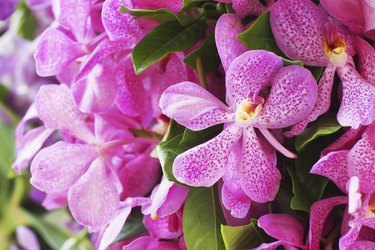
If you enjoy orchids and would like to try growing them, the types that grow and bloom indoors are nearly endless. One group of orchids called Mokaras (Mokara spp.) make good houseplants that can bloom year-round when given the proper environment. These plants need only basic care but also love warm temperatures, and can grow outdoors in U.S. Department of Agriculture plant hardiness zones 11 through 12.
The Best Environment
Video of the Day
Mokara orchids are hybrid plants, produced by crossing three genera called Vanda, Ascocentrum and Arachnis. They have a growth habit and cultural needs virtually identical to Vanda orchids and belong to a large group of orchids called the Vanda Alliance. Mokara plants do best when grown in daytime temperatures that stay above 65 degrees Fahrenheit. They're also heat resistant, tolerating daytime temperatures up to 95 degrees F. At night, above 55 degrees F is best, but a Mokara can withstand 40 degrees F for short periods. Never expose it to sub-freezing cold, which will kill the plant.
Video of the Day
A Mokara orchid needs high humidity, with 80 percent ideal. Place the pot on a pebble-filled tray or saucer, with water added to just under the tops of the pebbles. Use a nearby fan to keep air moving, which discourages fungal growth in the moist environment.
Light Requirements
The Mokara orchid blooms in many colors that include purple, pink, red, orange and yellow, with up to 10 flowers opening on a single stem. Strong light is an important factor in keeping the plant's leaves a bright green and in promoting regular flowering. For an indoor-grown plant, keep the plant on a south-facing windowsill where it gets full sun for at least part of the day. If you keep the plant in a greenhouse, provide it with about 25 to 35 percent shade during the sunny summer months, with slightly less shade on overcast winter days.
You can also keep a Mokara outdoors during the warm summer months, but expose it to bright outdoor light gradually and keep it in a spot that gets morning sun but is shaded during the hot mid-day and afternoon hours.
Water and Fertilizer
A Mokara orchid has an extensive root system and needs frequent watering, especially when grown outdoors in bright light. Water whenever the mixture is slightly dry on the surface, allowing water to run out of the pot freely -- this could be daily for an outdoor plant. Water less in winter when the plant's growth slows, allowing the mix to dry a bit more between waterings.
Fertilizing a Mokara orchid also promotes good growth, so feed once each week during spring and summer when growth is strong; change to every two or three weeks in winter when the plant's growth slows. Feed the plant with a balanced, 20-20-20 fertilizer diluted full-strength, or 1/4 teaspoon per gallon of water, but substitute a similarly diluted, high-phosphorous, 10-30-20 formula for every third feeding to promote flowering. Check labels of both products for additional directions.
Repotting and Problems
Like other members of the Vanda Alliance, Mokara orchids prefer their roots undisturbed. But if many roots extend outside the basket or pot, or the potting mixture becomes crumbly and breaks down, carefully remove the plant by first soaking it with its container in water -- this softens roots and makes them pliable. Re-pot into a slightly larger container, using a coarse, well-drained mixture such as fir bark or chopped tree fern, working it gently between the roots.
A Mokara orchid is usually free of diseases when grown under proper conditions. It's also usually pest-free, although it might attract mealybugs, which look like puffs of cotton that move. These are best destroyed by touching each one with a cotton swab dipped in rubbing alcohol.